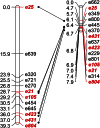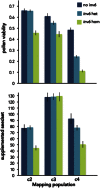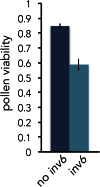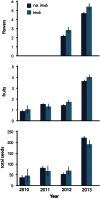A Segregating Inversion Generates Fitness Variation in Yellow Monkeyflower (Mimulus guttatus)
- PMID: 26868767
- PMCID: PMC4905537
- DOI: 10.1534/genetics.115.183566
A Segregating Inversion Generates Fitness Variation in Yellow Monkeyflower (Mimulus guttatus)
Abstract
Polymorphic chromosomal rearrangements can bind hundreds of genes into single genetic loci with diverse effects. Rearrangements are often associated with local adaptation and speciation and may also be an important component of genetic variation within populations. We genetically and phenotypically characterize a segregating inversion (inv6) in the Iron Mountain (IM) population of Mimulus guttatus (yellow monkeyflower). We initially mapped inv6 as a region of recombination suppression in three F2 populations resulting from crosses among IM plants. In each case, the F1 parent was heterozygous for a derived haplotype, homogenous across markers spanning over 5 Mb of chromsome 6. In the three F2 populations, inv6 reduced male and female fitness components. In addition,i nv6 carriers suffered an ∼30% loss of pollen viability in the field. Despite these costs, inv6 exists at moderate frequency (∼8%) in the natural population, suggesting counterbalancing fitness benefits that maintain the polymorphism. Across 4 years of monitoring in the field, inv6 had an overall significant positive effect on seed production (lifetime female fitness) of carriers. This benefit was particularly strong in harsh years and may be mediated (in part) by strong positive effects on flower production. These data suggest that opposing fitness effects maintain an intermediate frequency, and as a consequence, inv6 generates inbreeding depression and high genetic variance. We discuss these findings in relation to the theory of inbreeding depression and the maintenance of fitness variation.
Keywords: Mimulus guttatus; chromosomal rearrangement; inbreeding depression; polymorphism; variation.
Copyright © 2016 by the Genetics Society of America.
Figures






Similar articles
-
Divergent population structure and climate associations of a chromosomal inversion polymorphism across the Mimulus guttatus species complex.Mol Ecol. 2014 Jun;23(11):2844-60. doi: 10.1111/mec.12778. Mol Ecol. 2014. PMID: 24796267 Free PMC article.
-
Severe inbreeding depression is predicted by the "rare allele load" in Mimulus guttatus.Evolution. 2020 Mar;74(3):587-596. doi: 10.1111/evo.13876. Epub 2019 Nov 28. Evolution. 2020. PMID: 31710100
-
A high-resolution genetic map of yellow monkeyflower identifies chemical defense QTLs and recombination rate variation.G3 (Bethesda). 2014 Mar 13;4(5):813-21. doi: 10.1534/g3.113.010124. G3 (Bethesda). 2014. PMID: 24626287 Free PMC article.
-
Evidence of natural selection acting on a polymorphic hybrid incompatibility locus in Mimulus.Genetics. 2015 Feb;199(2):543-54. doi: 10.1534/genetics.114.171819. Epub 2014 Nov 25. Genetics. 2015. PMID: 25428983 Free PMC article.
-
The genetics of extreme microgeographic adaptation: an integrated approach identifies a major gene underlying leaf trichome divergence in Yellowstone Mimulus guttatus.Mol Ecol. 2016 Nov;25(22):5647-5662. doi: 10.1111/mec.13753. Epub 2016 Aug 10. Mol Ecol. 2016. PMID: 27393073
Cited by
-
Functional genomics of supergene-controlled behavior in the white-throated sparrow.Fac Rev. 2021 Sep 29;10:75. doi: 10.12703/r-01-000003. eCollection 2021. Fac Rev. 2021. PMID: 35146495 Free PMC article.
-
Are you with me? Co-occurrence tests from community ecology can identify positive and negative epistasis between inversions in Mimulus guttatus.PLoS One. 2025 Apr 28;20(4):e0321253. doi: 10.1371/journal.pone.0321253. eCollection 2025. PLoS One. 2025. PMID: 40294049 Free PMC article.
-
Genetic architecture of a body colour cline in Drosophila americana.Mol Ecol. 2020 Aug;29(15):2840-2854. doi: 10.1111/mec.15531. Epub 2020 Jul 13. Mol Ecol. 2020. PMID: 32603541 Free PMC article.
-
Population differentiation and structural variation in the Manduca sexta genome across the United States.G3 (Bethesda). 2022 May 6;12(5):jkac047. doi: 10.1093/g3journal/jkac047. G3 (Bethesda). 2022. PMID: 35191476 Free PMC article.
-
Population structure and local selection yield high genomic variation in Mimulus guttatus.Mol Ecol. 2017 Jan;26(2):519-535. doi: 10.1111/mec.13922. Epub 2016 Dec 19. Mol Ecol. 2017. PMID: 27859786 Free PMC article.
References
-
- Balanyà J., Serra L., Gilchrist G. W., Huey R. B., 2003. Evolutionary pace of chromosomal polymorphism in colonizing populations of Drosophila subobscura: an evolutionary time series. Evolution 57: 1837–1845. - PubMed
-
- Charlesworth D., Willis J. H., 2009. The genetics of inbreeding depression. Nat. Rev. Genet. 10: 783–796. - PubMed
-
- Coluzzi M., Sabatini A., della Torre A., Di Deco M. A., Petrarca V., 2002. A polytene chromosome analysis of the Anopheles gambiae species complex. Science 298: 1415–1418. - PubMed
Publication types
MeSH terms
Grants and funding
LinkOut - more resources
Full Text Sources
Other Literature Sources
Miscellaneous

